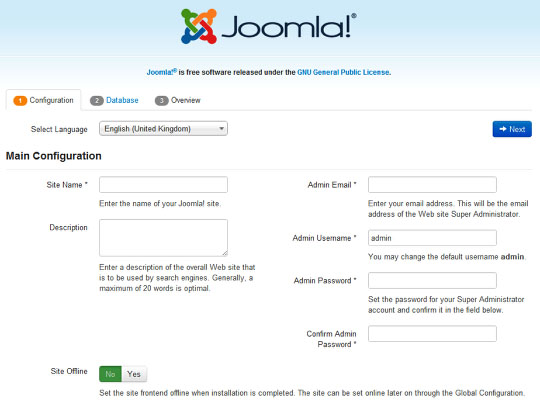,
In this tutorial, we will show you how to install Joomla on Ubuntu 20.04 LTS. For those of you who didn’t know, Joomla is a free and open-source popular content management that uses PHP and a backend database, such as MariaDB. It has thousands of free extensions and templates allowing you to customize your site to fit your specific needs and ships with lots of PHP code, plugins, and themes that can help you get started from the ground up in no time.
This article assumes you have at least basic knowledge of Linux, know how to use the shell, and most importantly, you host your site on your own VPS. The installation is quite simple and assumes you are running in the root account, if not you may need to add ‘sudo‘ to the commands to get root privileges. I will show you through the step-by-step installation of Joomla on an Ubuntu 20.04 LTS (Focal Fossa) server.
Prerequisites
- A server running one of the following operating systems: Ubuntu 20.04, 18.04, and any other Debian-based distribution like Linux Mint or elementary OS.
- It’s recommended that you use a fresh OS install to prevent any potential issues.
- A
non-root sudo useror access to theroot user. We recommend acting as anon-root sudo user, however, as you can harm your system if you’re not careful when acting as the root.
Install Joomla on Ubuntu 20.04 LTS Focal Fossa
Step 1. First, make sure that all your system packages are up-to-date by running the following apt commands in the terminal.
sudo apt update sudo apt upgrade
Step 2. Install LAMP server.
A Ubuntu 20.04 LAMP server is required. If you do not have LAMP installed, you can follow our guide here.
Step 3. Installing Joomla on Ubuntu 20.04.
For this step, you need to download Joomla’s installation package from the Official Joomla’s website. To do this, run the wget command:
wget https://downloads.joomla.org/cms/joomla3/3-9-20/Joomla_3-9-20-Stable-Full_Package.zip mkdir /var/www/html/joomla unzip Joomla_3-9-20-Stable-Full_Package.zip -d /var/www/html/
Next, change the permissions and set the directory ownership of the directory to Apache user:
sudo chown -R www-data:www-data /var/www/html/joomla sudo chmod -R 755 /var/www/html/joomla
Step 4. Configuring MariaDB for Joomla.
By default, MariaDB is not hardened. You can secure MariaDB using the mysql_secure_installation script. You should read and below each step carefully which will set a root password, remove anonymous users, disallow remote root login, and remove the test database and access to secure MariaDB.
mysql_secure_installation
Configure it like this:
- Set root password? [Y/n] y - Remove anonymous users? [Y/n] y - Disallow root login remotely? [Y/n] y - Remove test database and access to it? [Y/n] y - Reload privilege tables now? [Y/n] y
Next, we will need to log in to the MariaDB console and create a database for the Joomla. Run the following command:
mysql -u root -p
This will prompt you for a password, so enter your MariaDB root password and hit Enter. Once you are logged in to your database server you need to create a database for Joomla installation:
MariaDB [(none)]> CREATE DATABASE joomla_db; MariaDB [(none)]> GRANT ALL ON joomla_db.* TO ‘joomla_user’@’localhost’ IDENTIFIED BY ‘Your-PasswD’; MariaDB [(none)]> FLUSH PRIVILEGES; MariaDB [(none)]> EXIT;
Step 5. Configuring Apache for Joomla.
Create a virtual host file for Joomla to configure the Apache webserver to server Joomla web pages:
nano /etc/apache2/sites-available/joomla.conf
Add the following lines:
<VirtualHost *:80> ServerName joomla.example.com ServerAdmin webmaster@example.com DocumentRoot /var/www/html/joomla <Directory /var/www/html/joomla> Allowoverride all </Directory> </VirtualHost>
Now enable the Joomla virtual host file and disable the default configuration file:
sudo a2dissite 000-default.conf sudo a2ensite joomla.conf
Then restart the Apache webserver service for the changes to come into effect:
sudo systemctl restart apache2
Step 6. Accessing Joomla.
Joomla will be available on HTTP port 80 by default. Open your favorite browser and navigate to http://your-domain.com and complete the required steps to finish the installation. If you are using a firewall, please open port 80 to enable access to the control panel.

Congratulations! You have successfully installed Joomla. Thanks for using this tutorial for installing Joomla CMS (content management system) on Ubuntu 20.04 Focal Fossa systems. For additional help or useful information, we recommend you to check the official Joomla website.